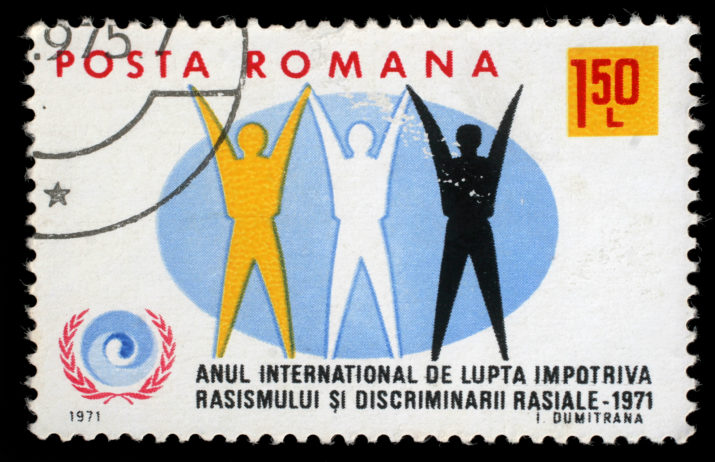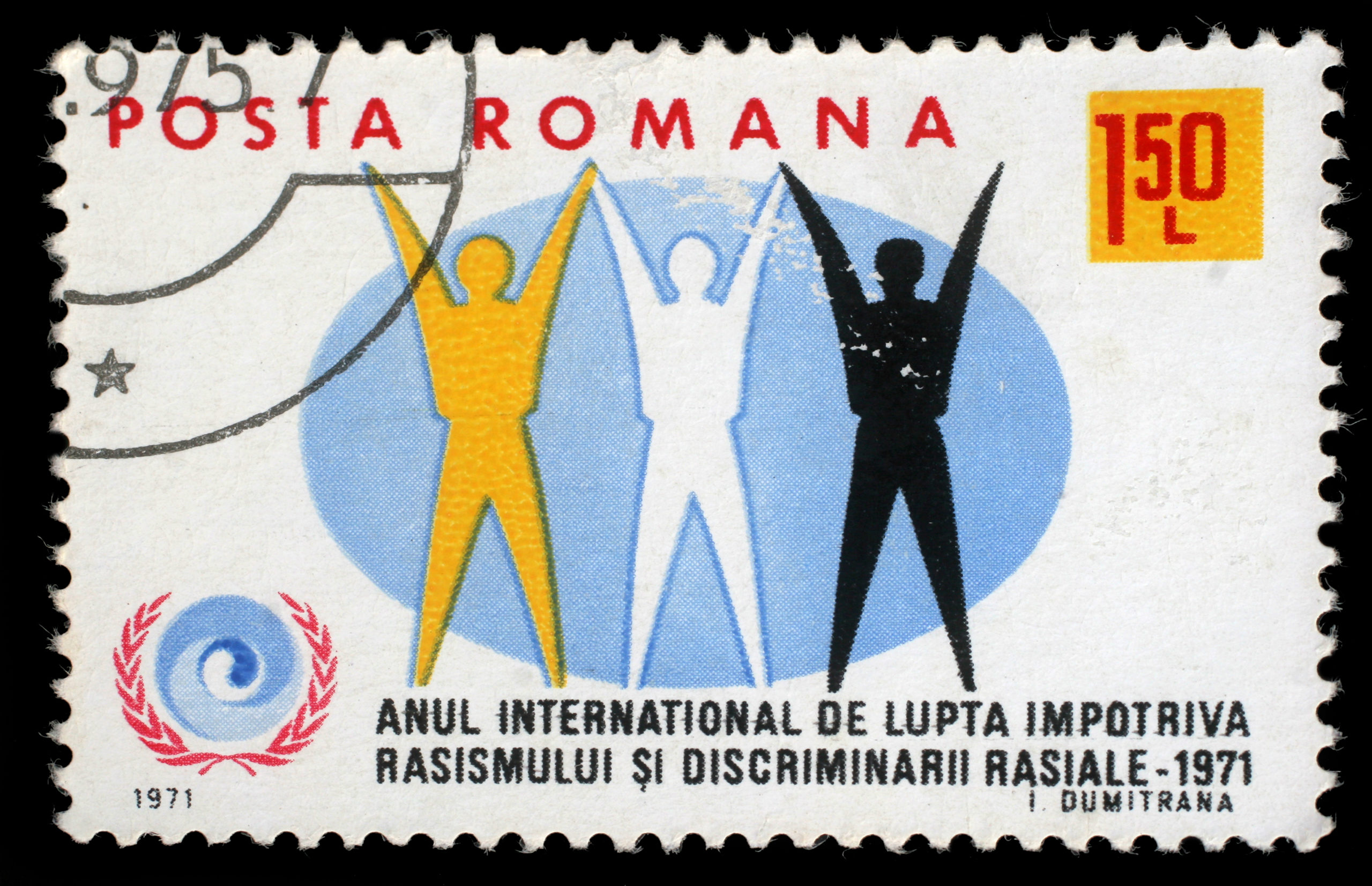

This is part of a Roundtable, Ideas of Race, Ideologies of Racism: Roma Rights in Europe during the #BLM moment.
The Black Lives Matter (BLM) movement, and more specifically, the public lynching of George Floyd by Minneapolis police, sparked a collective investigation into the racial logics of white supremacy that supports racist systems in the United States. The sentiments, frustrations, and anger expressed in the BLM protests that took place in the US last year are familiar to marginalized peoples across the globe who are all affected by racializing processes of global white supremacy, the colonial matrix of power, and global capitalism. It comes as no surprise that other racialized peoples’ struggles for liberation were invigorated as BLM protests spread from coast to coast. The ripples of the BLM protests in Europe, however, failed to incite a similar reckoning on the other side of the Atlantic. This was due in part to the indifference and in some cases even European contempt for BLM. My own disappointment, as a Romani activist and scholar, stemmed from the fact that the Roma, Europe’s largest racialized minority, were markedly absent from these discussions.
The BLM movement spurred the idea that present discrimination is rooted in historical persecution and that behind the visible manifestations of racism (police brutality, job discrimination, etc.) lie ideologies that contribute to the justification or legitimization of these forms of discrimination and violence (white supremacy). In a similar way, it is vitally important that European societies historicize the persecution of Romani people in Europe. In the European space, when it comes to public opinion about the Roma a genealogical tracing of race and racism is rare. This means that in the zeitgeist of grappling with the historical legacies of colonialism in Europe, the Roma have been largely left out of these important conversations. This lack of a historical long-view and of the reality of systemic racism against the Roma, has hindered the ability of European societies to understand the nuanced history of Romani people in Europe and its repercussions in the present. A poignant example of the way in which European societies have misread racism towards the Roma took place in Romania in April 2020 when a video depicting police brutality against a Romani person surfaced on social media. The occurrence instigated an onslaught of hate speech against the Roma on social media, rather than a critique of institutional state-sponsored violence, as would have been expected.[1] In this case and many others like it, racially motivated persecution is considered to be a legitimate response to the inherent “asocial,” “criminal,” or deviant behavior of Romani individuals.
The interpellation of Romani life into the body politic, or the way in which the Roma have been folded into European society, has been dictated by Romani status as a negative referent for European whiteness. Romani peoples have long been racialized, demonized, or romanticized in the social imaginary, as slaves, criminals, vagabonds, spreaders of disease, or hypersexualized figures. As a social construct, race is a process by which human life is ordered and placed on a hierarchy. The drive to fabricate this racial boundary has historically always served a broader economic and political agenda, including colonization, the transatlantic slave trade, and the subjugation of the Roma in Europe. The ideological framework that underpins the figure of the Roma as an “ontological other” in contrast to the white Western man, to use Sylvia Wynter’s paradigm, is due to a categorization of Romani people as an “internal Orient” to Europe, which plays into larger nationalist projects and the construction of whiteness in Europe.[2] As Sam Beck wrote over thirty years ago, Romani people were racialized during slavery, which meant that “Romanians could increasingly identify themselves in contradistinction to their low-class status, a process that helped shape the Romanian national states and Romanian ethnic identity.”[3]
Anti-Roma sentiment lies at the epicenter of rising populism in Europe, as Romani people are victim to countless attacksin the form of police brutality, neo-Nazi pogroms, or fascist policies.[4][5] In October of 2020, a far-right party named Alliance for the Union of Romanians (AUR) won representation in parliament in Romania. Sorin Lavric, one of the party’s most vocal leaders, referred to Romanian Roma as a “social plague” during the first months of the pandemic. This at a time when Romanian mass-media also fervently scapegoated the Roma as the main harbingers of the disease. In an interview at the end of last year, Lavric stood by his racist comments, digging his heels in even further in stating that, “statistically speaking,” the Roma have a predilection towards stealing. He intones, along with Antonescu, Himmler, and others the same stereotypes of “Gypsy criminality” and “plague,” which led to the interment and genocide of the Roma during the Holocaust.[6] Lavric’s rhetoric is not “realist,” “anti-establishment,” nor simple reactionary politics to the oppressive “neo-Marxist” climate of political correctness. It is cut from the same cloth as twentieth-century eugenicist and fascist discourse. More recently, Lavric even proposed legislation in parliament that would venerate the “heroes” of the Iron Guard, a fascist political movement established in 1927 in Romania.[7]
Roma as subjects of coloniality
International polls across Europe show that xenophobia towards the Roma is widespread.[8] Itzigsohn and Brown’s book, in which they trace the phenomenology of racialized subjectivity in what they call “racialized modernity,” together with Walter Mignolo’s assertion that coloniality and modernity are co-constructed, explains how the epistemological tendrils of coloniality and white supremacy could have infiltrated even Eastern European society in spite of the fact that countries there (for example Romania and Bulgaria) were not imperial powers.[9] Evidence of racialized forms of persecution abound, yet critiques of whiteness, Eurocentrism, and racism in Europe have not sufficiently addressed how the tendrils of coloniality have touched the lives of Romani peoples, affecting their subjectivity in ways that resonate not only with Du Boisean “double-consciousness” but also other theories of subject formation. Thus, there is a need to re-position current discourses surrounding class, culture, and race vis-à-vis the Roma via an intersectional and critical lens.
The history of Romani persecution is often relegated to the peripheries of mainstream or hegemonic history—what Chakrapbarty calls “History 1.”[10] The Roma are often painted as primitive, unintegrated into “modern” society, antithetical to modernity itself, and a backward people. Romani people and history, thus, remain unincorporated into global discussions of coloniality and white supremacy. Instead, the academy and wider society should recognize the Roma as central figures in present day reckonings about past racial injustice. As Walter Mignolo states, “[c]oloniality is constitutive, not derivative, of modernity. That is to say, there is no modernity without coloniality, thus the compound expression: modernity/coloniality.”[11] Thus, Romani people as modern subjects are also by default modern/colonial subjects, as “[t]here is no outside of the Cmp [colonial matrix of power].”[12] Therefore, the subjugation of the Roma should be considered as part of coloniality, influenced by the ideas and ideologies of race circulating and driving political and economic processes at the time. The Roma should and need to be folded into discourses and processes of colonialism and white supremacy, not simply in order to advance mobilizations for Romani rights, but also to better understand European ideologies of race and racism. The Roma are central to the historical and contemporary manifestations of race and racism in the European space. Any discussion of racism and colonialism in Europe remain incomplete without a critical integration of the situation of the Roma within those racializing mechanisms as the Roma have been central to the mechanisms of racism, exploitation, and xenophobia, persecuted in manifold ways from the extraction of their labor as an enslaved people to their genocide.
Recognition and reconciliation
An important facet of the ongoing discrimination of Romani people is the institutionalization of ignorance surrounding Romani trauma stemming from their history of slavery, genocide, and forced assimilation. Lack of knowledge and awareness contributes to the illegibility of Roma suffering and historical violence, which in turn informs and structures present-day discrimination of Roma. We can turn to the enslavement of the Roma in Romania, an often-forgotten part of European history, as an example of this historical amnesia. At the center of the Black Lives Matter moment is a reckoning with the historical trauma of slavery, Jim Crow laws after the abolishment of slavery, and what Michelle Alexander calls the “New Jim Crow.” No such collective engagement exists in European society about the historic trauma endured by the Roma in Europe. The framework of transitional justice applied to Romani historical injustice would radically change the way we think about the contemporary situation of the Roma today. This is long overdue in the case of Romani slavery—a large-scale, institution and systemic human rights violations, which was never accorded due attention. Since the abolishment of slavery 165 years ago, there simply has not be an adequate response to Roma persecution. There have been ineffective, misguided, and half-baked efforts to attempt a truth and reconciliation process, but they have not succeeded in shifting the antagonism with which Romani “issues” are framed by dominant society.[13] Preservation of memory is important for the struggle for recognition, acknowledgement, and reconciliation; it also informs how those in positions of power to make systemic change understand the challenges Romani people face. Reconciliations can look like reparations, apologies, commemorations, memorials, or instituting educational programs about Romani persecution that would sensitize non-Roma to trauma of the past. All should inform the policies and actions they take in attempting to remedy the disparities in present day society. In enacting these policies, we begin to forge civic trust, as well as individual and collective healing after trauma. It is imperative that, when we consider historical injustice towards the Roma through the lens of truth and reconciliation, the past injustice be recognized as not only a social, but also an economic problem, hence requiring both social and economic solutions. In addition to including Romani history in school curriculums to address the lack of collective knowledge about the Roma, there is also a need for reparations to address the financial ramifications of historic persecution.
Academic work documenting the horrors of Romani enslavement exists and attests to child separation, chattel slavery, cruel beatings, and other violent forms of punishment; Enslaved Roma were hung over smoking fires, placed in solitary confinement, and thrown into frozen rivers.[14] Yet, one of the largest holders of slaves, the Orthodox Church, refuses to apologize for the prominent role the institution played in the enslavement of Romani people for over 500 years in the Romanian Principalities before the abolition of Slavery in 1856. This refusal is anchored in a society that barely recognizes the persecution of the Roma during the Holocaust, where Romani survivors are not decorated alongside Jewish survivors and are refused reparations to which they are entitled by law. Reconciliation is a multi-faceted process that also means recognition. However, European society has yet to take the first step towards it. European society must recognize the enslavement and genocide of the Roma as a formative part of European history—as history with material, social, and economic repercussions in the present. The enslavement of the Roma was an exploitative economic and social system, with tangible effects today on the economic situation of the Roma, their social position, and the way they are treated. There is a wealth gap between Roma and non-Roma and their disenfranchisement and past enslavement is a direct cause of that gap, as enslaved Roma and their descendants could not accumulate wealth as enslaved peoples. A new study finds that 80 percent of Romani people in Europe are at risk of poverty.[15] It is no accident that the racialized minority group in Europe that was victim to both genocide and enslavement have the highest poverty rates in Europe. Slavery greatly impacted the lives of Roma; the enduring legacies of slavery even after it was abolished mirrors in many ways the liminal experience between enslaved and free that was also the case in the US. The history and afterlives of Romani slavery are vital aspects of European history that should be brought to light both out of a moral imperative, in order to enact restorative justice of an oppressed people, and also to better inform policies designed to improve the situation of Roma.
For centuries, the mere existence of the Roma in the world has been considered a problem by fascist regimes in Europe that were intent on destroying the Roma. These regimes framed their existence as the “Gypsy problem” and the legacy of this thinking remains embedded in current discourses. In general, European societies need a radical awakening to a new political consciousness that completely reformulates the way in which they think about the Roma and the challenges that Romani communities face. Part of this reclassification refers to the recognition of complicity and responsibility in building a world in which Romani people face social, structural, institutional, and systemic racism. Neo-Nazi pogroms, white supremacist marches sanctioned by the state against the Roma, the political scapegoating of the Roma, lack of access to basic utilities or health services, and police brutality are examples of challenges Romani people face in Europe today. Eugenicist and Nazi discourse categorizing Roma and Sinti as criminals and asocials mirrors contemporary discourse. It has been seventy years since the Holocaust, but ideologically we have not made enough progress in changing our epistemological framings vis-à-vis Romani life. Until our thinking is reversed—until we realize that the real problem lies in the structures and systems that support white supremacy in our society and recognize the current effects of historical persecution on the Roma—we have very little hope of creating a world that is fair and equitable for all, including for the Roma.
Coalition building
Many parallels exist between historical lived experiences of racism by Romani subjects and African Americans. Yet, I tread carefully when drawing heavily from Black feminism and Black studies, given my discomfort and fear about making Black life an analogy. However, putting these two worlds in conversation usefully brings to light the different ways in which processes of domination, exploitation, and empire have played out in different parts of the world. I do not wish to paint all racial persecution in homogenizing brushstrokes as white supremacy without the nuance and specificity of local contexts, as this would problematically dilute the severity of anti-blackness. In my comparative perspective, I take the lead from the coalition building modeled by Cornell West, Margarata Matache, Sunnie Rucker-Chang, and others in uniting Roma struggle and the movement for Black lives against our common foes: white supremacy and coloniality.[16]Our task as scholars committed to justice and decoloniality is to seek to understand the “colonial matrix of power” in order, ultimately, to be able to destroy it. And to truly understand it, to historicize the formation of race in Europe, the Roma, as a formerly enslaved people who were also targets of genocide, must have a seat at the table. As a Romani person watching and participating in the unfolding of the legacies of colonialism and anti-Blackness, I see a great need to integrate the Roma into current conversations about decolonialism and Europe’s investment in ideologies of white supremacy, which has underpinned Romani enslavement, genocide, and ongoing discrimination.
Some activists and even members of European parliaments took to the habit of intoning the derivative slogan Roma Lives Matter. As mentioned, anti-Roma sentiment and the history of abjection of the Roma has resonances, but also discordances, with the plight of African-Americans. I can understand the desire to align ourselves with their work. However, I maintain a discomfort at the phrase “Roma Lives Matter,” as Black Lives Matter is a movement specific to theracial persecution being waged against Black people in the United States. Appropriating their slogan is not a gesture of solidarity; rather, it usurps and undermines their work. It turns Black lives into an analogy, and uses Black suffering to platform Roma suffering in a violent appropriation that dehumanizes Black suffering.
It would be unhelpful to impose the hegemony of US imperial models of race on Europe, as ideologies of race and racism in European space especially vis-à-vis the Roma have different genealogies. Including the Roma in contemporary thinking on decolonialism and anti-racism should not be enacted through reductionist relativism because that would of course be counterproductive. I do not here intone false equivalences of misguided elisions. Nonetheless, it is vital that European societies in the #BLM zeitgeist reflect on their own investment in whiteness, and the role that the exploitation of the Roma played in that investment. Linking Romani struggles for liberation with the Black Lives Matter movement is not about usurping one struggle in the name of another or about putting an equal sign between them. First and foremost, it is about solidarity in the face of white supremacy. As Audre Lorde famously wrote “there is no hierarchy of oppressions.” The gesture of inclusion of Roma into global reckonings on race is about understanding the global interconnectedness of racial oppression. We might imagine oppression as a Deleuzian-Guattarian rhizomatic structure, wherein racialized peoples across the globe are nodes in an interconnected network of oppression. Through this paradigm, it becomes clear that we can only combat the sprawling network of white supremacy with multivocal, multinodal (i.e. from multiple standpoints and subject positions) responses.
While writing this piece, my newsfeeds on social media were riddled with human rights violations, from the infringement on a woman’s autonomy over her own body, to water cannons being blasted at protesters on Standing Rock waging the same war their ancestors fought to protect sacred lands―lands “protected” by treaties meant to curtail white settlers from further theft. We are still living amongst the perpetual ripples of colonialism, slavery, patriarchy, extraction, and exploitation. Extraction and burning of fossil fuels is significantly contributing to global warming, yet some elected officials deny science as if it is a matter of opinion. It took a global pandemic for the US and the murder of countless Black and brown people―not bodies, but humans―for racial inequalities to become legible and for the insidious logics of necropolitics—which encompasses everything from police lynchings to lack of access to health care—to be revealed. Such a list of inequalities, exclusions, and discriminations, maps onto Romani experience and yet, these human rights violations are still not legible to European societies that are content to critique their transatlantic comrades over colonization, while refusing to see the putrid racism, xenophobia, sexism, and transphobia, at home. A continuous history of systematic killing, genocide, and pogroms bleeds into the present. As Sunnie Rucker-Chang writes in her contribution to this roundtable, “This global ‘anti-racist’ moment presented an opportunity to acknowledge and reckon with how systemic racism and marginalization affects the largest minority communities in Central and Southeast Europe, but that did not happen; the moment has passed.” The moment passed, however, the sliver of hope I maintain is fed by the activists, protesters, and feminists, who show deep commitment to challenging white supremacy in all its forms.
Ioanida Costache is a Ph.D. candidate at Stanford University in ethnomusicology. Her research explores issues of race and ethnicity, performance/construction of identity, cultural memory, trauma, and history as they intersect in Romanian-Romani musico-oral traditions.
References:
[1] Cătălin Tolontan and Denisa Dudescu, “Imagini De Juntă Militară. Cum Pedepsește Poliția Română Un Grup De Bărbați Din Bolintin. Romi Culcați Pe Jos, Cu Mâinile La Spate Și Bătuți. Explicațiile IPJ Giurgiu,” Libertatea, April 23, 2020, (accessed March 15, 2021).
[2] Sylvia Wynter, “On Disenchanting Discourse: ‘Minority’ Literary Criticism and Beyond,” Cultural Critique, no. 7 (1987), https://doi.org/10.2307/1354156.
[3] Sam Beck, “The Origins of Gypsy Slavery in Romania,” Dialectical Anthropology 14, no. 1 (1989), https://doi.org/10.1007/bf00255926.
[4] Marton Dunai, “Four Jailed for Neo-Nazi Killing Spree That Terrified Hungary’s Roma,” Reuters, Thomson Reuters, August 6, 2013, (accessed March 15, 2021).
[5] An NGO in Romania, Romani CRISS documented 48 cases, between 2006-2015. As a result of the police brutality, 7 Roma people were killed and 187 were beaten/tortured, for which they needed a total of 650 days of medical care. A full report can be found at this link: http://drepturile-omului.info/wp-content/uploads/2015/06/Factsheet-Politie.pdf?fbclid=IwAR3HVQqtsM4vP2pMEecloRlltlbG7bak-VP5ELB5GwqdHOWmxJwBRqNUHLs
[6] Ovidiu Nahoi, “DECRIPTAJ/ De Vorbă Cu Ideologul AUR: Despre ‘Țigani’, ‘Handicapați’, ‘Război Ideologic’ Și ‘Revoluția Conservatoare’ Care Se Amână,” RFI România, December 11, 2020, (accessed March 15, 2021), www.rfi.ro/emisiunile-rfi-ro-128454-decriptaj-de-vorba-cu-ideologul-aur-despre-tigani-handicapati-razboi?fbclid=IwAR2t_b4DCzFboTNQzn3CogtnX6AWG7ucKfDhfSHydQtQv9SWHJCvwRztG3Y.
[7] Robert Kiss, ed., “Senatorul AUR, Sorin Lavric, Elogii Pentru Foști Legionari. Vexler (Minorități): Este o Umilință Îngrozitoare La Adresa Victimelor,” Digi24, March 8, 2021, (accessed March 29, 2021), www.digi24.ro/stiri/actualitate/politica/senatorul-aur-sorin-lavric-elogii-pentru-fosti-legionari-vexler-minoritati-este-o-umilinta-ingrozitoare-la-adresa-victimelor-1464522.
[8] For example, a 2018 poll in Romania found that 29% of respondents would not accept a Roma person as a member of their family. According to a survey conducted in France, 50% of respondents thought there were too many Roma in France. https://www.sudouest.fr/justice/racisme-une-prise-de-conscience-paradoxale-avec-des-prejuges-persistants-1637861.php
[9] José Itzigsohn and Karida L. Brown, The Sociology of W. E. B. Du Bois. Racialized Modernity and the Global Color Line(New York University Press, 2020)
[10] Chakraarty, Dipesh, Provincializing Europe: Postcolonial Thought and Historical Difference (Princeton: Princeton University Press, 2000).
[11] Mignolo, Walter D., and Catherine E. Walsh, On decoloniality: concepts, analytics, praxis. (Durham: Duke University Press, 2018) 4.
[12] Ibid., 252
[13] In 2007, the Government of Romania adopted a resolution to establish a commission to study Roma slavery, however, the commission to date has produced no tangible results. In 2011 Romania law 28/2011 was ratified by the Romanian parliament, declaring February 20th as a day commemorating the liberation of Romani people from slavery.
[14] See Petre Petcuţ, Rromii: Sclavie Şi Libertate: Construirea Şi Emanciparea Unei Noi Categorii Etnice Şi Sociale La Nord De Dunăre: 1370-1974 (Bucureşti: Editura Centrului National de Cultură a Romilor, 2016) and Adrian Nicolae Furtuna, Sclavia Romilor in Tara Romaneasca. Roma Slavery in Wallachia (Bucureşti: Editura Centrului Naţional de Cultură a Romilor, 2019).
[16] Margareta Matache and Cornel West, “Roma and African Americans Share a Common Struggle,” The Guardian, Guardian News and Media, February 20, 2018, (accessed March 15, 2021) www.theguardian.com/commentisfree/2018/feb/20/roma-african-americans-common-struggle.
Photo: ROMANIA – CIRCA 1971: a stamp printed in Romania shows International Year against racism, circa 1971 | Shutterstock




